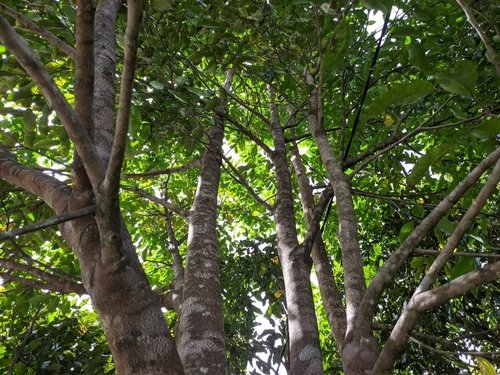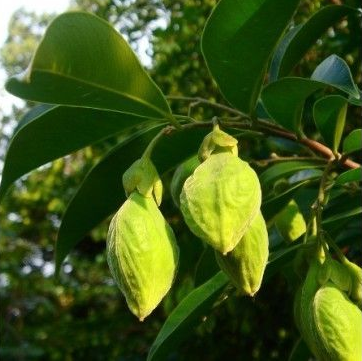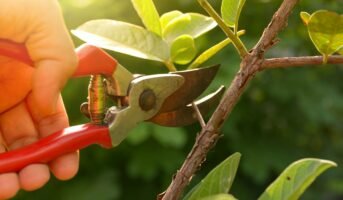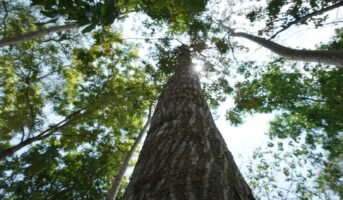Hailed as the ‘Wood of the Gods,’ Agarwood has been grown and traded for centuries. The tree’s scientific name is Aquilaria, also commonly known as Gaharu or Aloe wood in India. The tree’s origin is believed to be in Assam, India, but it is also cultivated in the Middle East, Taiwan, Japan and China. The tree also finds its place in religious ceremonies and is supposed to have healing properties.
The tree is famous for its wood and oil and can grow up to 40 m tall and around 80 cm in width. The fungus, Phialophora, attacks the wild tree, giving dark embedment to the heartwood. The wood has a distinct smell and thus is also widely used in perfumes.
See also: Sagwan tree: Facts, growth, maintenance and uses of Tectona grandis

See also about: sagwan tree
Agarwood tree: Key facts
| Botanical name | Aquilaria Malaccensis |
| Common name | Agar, Aloeswood, Gaharu |
| Family | Thymelaeaceae |
| Native area | Assam, Bhutan, Indonesia, Thailand. |
| Plant-type | Non-timber resinous wood. |
| Mature size | 40 m |
| Sun exposure | Full sun exposure |
| Soil type | Sandy clay soil |
| Flower size | 6 mm |
| Flower colour | Dirty-yellow or green |
| Toxic | Non-toxic |
Agarwood tree: Characteristics
The agarwood tree is a highly protected species of tree in India under the IFA (Indian Forest Act), 1927. On the brink of extinction, the tree is well-known in the incense-making industry. The tree is believed to have originated in the Indian state of Assam. Along with northeast India, the tree is also grown in Burma, Indonesia, Thailand, and even Papua New Guinea. Chinese people have used this tree’s wood as a sedative and aphrodisiac.
The oil obtained from the tree is also rich in anti-inflammatory properties. The tree grows well in hilly regions with direct sunlight. It needs sandy and yellow soil. The perfect temperature is about 25-33 degrees Celsius, and the rainfall required is around 4000 mm. The tree sprouts small yellow flowers that are 6mm in size. The fruits produced by the tree look like eggs in shape; their seeds and barks are edible.
There are approximately 21 species of agarwood trees.

Source: Pinterest
Agarwood tree: How to grow it?
Since growing an agarwood tree is complicated, seeds or artificial inoculation are the best methods to produce one.
Growing agarwood by seeds
Identify the fruits that contain healthy seeds and collect them. The best season to collect the seeds is November to December. You can store the seeds in a fridge for two months. Use seeds from older mother trees. Soak the seeds in fungicide for 4 hours, then discard the rotting seeds. Plant the seeds in potting trays filled with soil mix. Cover the seeds with plastic wrap.
Once new shoots appear, transferring the plants from pots to nursery bags reduces the chances of root penetration. Direct sun is required for good growth, the temperature of around thirty-three Celcius is optimal. Proper techniques and skilled labour are needed to grow many seedlings that will grow into healthy trees.
Ideal soil and climate for growing Agarwood trees
Agarwood trees thrive in hilly regions situated at altitudes higher than 750 metre above sea level. They can be cultivated in various types of soil, including clay, sandy, and yellow or red podzolic soil. Optimal growth occurs within temperature ranges of 20°C to 33°C, while a relative humidity level of 77-85% is ideal for their cultivation.
Preparing the land for Agarwood farming
If the ground conditions are not suitable, the tree can die in four years. To reduce mortality, plant the trees in sloping land; that way, the water from rainfall will not stay stagnant and flow downwards. After the saplings reach a height of around 60-90 cm, they can be transferred to the soil. The hole should be 40 x 40 x 40.
Add coco peat to hard ground. Mixing Triple Super Phosphate (TSP) will provide the needed phosphorus to the ground. Organic fertilisers like cow dung also need to be added. Two inches of the seedlings should be above the surface, and the rest of the hole should be covered with soil.
Using artificial inoculation to collect resins
This process is only for fungal inoculation. In this process, fungi are induced in the xylem of the tree. In just three hours, the inducer travels through the whole tree and causes wounds in parts like roots, trunks and thick trunks. Resinous wood gets formed in those wounded parts when left alone for a few months. The high-quality wood can then be separated from the resin during harvesting.
Read also: Mahogany tree: How to take care of it and use it the right way?
Agarwood tree: Care tips
Agarwood tree: Sunlight requirement
Agarwood trees need ample sunlight to flourish. When selecting a location, ensure it receives direct sunlight for a minimum of 5-6 hours daily. Planting them in a shaded area will impede their growth and expansion.
Agarwood tree: Soil requirement
Agarwood trees thrive in soil that drains well and is enriched with organic matter. It is best to have a slightly acidic growing medium with a pH ranging from 5.5 to 7.5. If the soil becomes too alkaline, nutrient absorption may be hindered, leading to compromised growth and resin production.
Agarwood tree: Water requirement
Agarwood trees need regular watering to ensure healthy growth. Water the tree when the topsoil feels slightly dry to the touch. During its initial growth stage up to around 4-5 feet in height, you should provide the necessary watering. Once it reaches that stage, the tree becomes more self-sufficient in managing its water needs.
Agarwood tree: Fertiliser requirement
Agarwood trees can benefit from regular feeding to enhance their growth. Use a balanced liquid fertiliser every two months until the tree reaches a height of 4-5 feet. Once it reaches that height, you can discontinue fertilising as the tree becomes more self-sustaining.
Pruning an Agarwood tree
The tree tends to mature fast and double in size with dense multiple branches, so constant pruning is required. To maintain a pleasing silhouette, cut down the extra branches that grow from the main branches. Cut down rotten or damaged leaves to let the healthy leaves thrive.
Harvesting an Agarwood tree to collect heartwood
Once the tree gets damaged either naturally or by artificial inoculation, the fungus enters the tree’s system and produces a dark, fragrant substance called ‘resin’ which fuses with the heartwood.
Once the tree matures and resin is wholly produced, use an electric hand drill to cut holes in the tree to check the condition. If the tree is good to be cut down, chop down the tree’s trunk into small logs, which can then be sent to the processing plant.
Agarwood tree: Pests and diseases
Agarwood trees can be vulnerable to pests like termites, wood borers and leaf miners, as well as fungal infections. It is important to take preventive measures and use insecticides and fungicides to control these issues and protect the health of the trees. Regular monitoring and timely treatment can help maintain the well-being of the agarwood trees.
Agarwood tree: Yield
Since agarwood tree cultivation depends mainly on the growing fungus that produces resin, it takes about 15 years for the process to be complete. The tree will be profitable only if it is affected by the fungus properly. But artificial techniques do speed up the process. Only around 1500 agarwood trees can be planted on an acre at once.
The average yield from a single agarwood tree is about 5 kg. A 70 kg of wood only secretes about 20 ml of oil. But since agarwood is one of the most expensive selling timber, the business, if done correctly, is very profitable. Agarwood has a global market price of US 8 billion.
Agarwood tree: Benefits and uses
- In India, agarwood finds many beneficial uses as they are antiasthmatic, antidysenteric and anti-diarrhoea.
- Agarwood (wood of the Gods) also finds its usage in ceremonial practice in Indian, Chinese and Buddhist communities. Incense sticks and ritual oils made from agarwood are used in religious practices.
- Essential oils extracted from the heartwood are used in luxury perfumes and as a scenting agent in soap and shampoos.
- The wood and bark of the tree find their use in rope, paper and cloth-making industries.
- In Malaysia, agarwood is believed to help cure jaundice and body aches.
Agarwood tree: Toxicity
The agarwood tree is non-toxic. Agarwood is cultivated widely in India and other parts of Asia, mainly for its pharmaceutical properties and alluring fragrance. The wood and oils collected from it have been used for religious purposes for ages. The leaves are also used in making food like tea.
FAQs
Can I grow agarwood at home?
If your local climate is suitable, growing an agarwood plant at home is indeed possible. However, it's essential to place the plant at least 10 feet away from any nearby structures or walls.
Can agarwood be grown in India?
In India, agarwood is classified as an endangered species by the environmental department. However, artificial cultivation can be found in the northeastern region, particularly in the state of Assam.
What is the price of agarwood plant per kg?
In India, the approximate value of Agarwood is around Rs 5-6 lakh per kilogram. In the international market, the price can increase by 2-3 times depending on the specific market conditions.
Which type of agarwood is best?
Within the Aquilaria family, which consists of 25 species, only 19 can produce Agarwood. Of these, the Aquilaria Crassna species in Vietnam is known for producing the world's finest Agarwood.
How many varieties of agarwood tree are there?
To date, 21 species of the Aquilaria trees are documented, out of which 13 are known to be agarwood-producing trees. Aquilaria crassna, the species grown in Vietnam, is the best agarwood variety known.
How long does it take for agarwood to grow?
In farms, agarwood can mature in three to five years. Then the tree is ready to be harvested. It may take a decade for the trees to develop in the forest.
What is the general height of an agarwood tree?
The trees can reach a height of 40 m when fully mature.

Dhwani is a content management expert with over five years of professional experience. She has authored articles spanning diverse domains, including real estate, finance, business, health, taxation, education and more. Holding a Bachelor’s degree in Journalism and Mass Communication, Dhwani’s interests encompass reading and travelling. She is dedicated to staying updated on the latest real estate advancements in India.
Email: [email protected]











